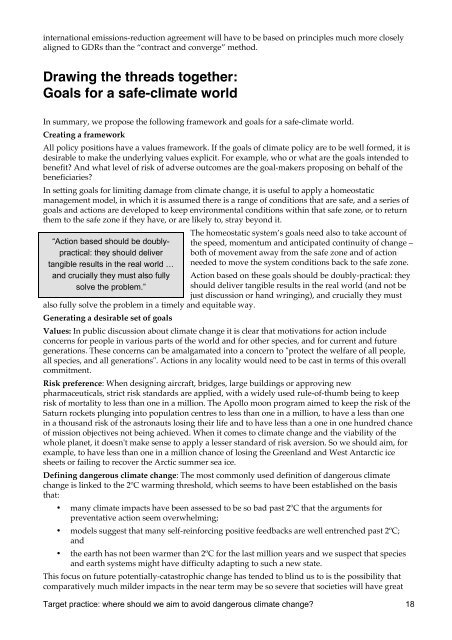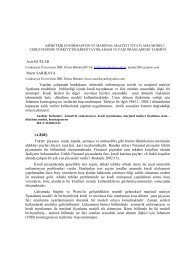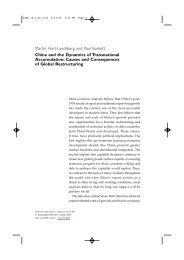the same emissions quota or ration, is not a practical possibility on equity grounds, or politically. Thedeveloped economies are responsible for most his<strong>to</strong>ric atmospheric carbon emissions (and indeedmost emissions since 1990), and they have a greater responsibility and a greater capacity <strong>to</strong> mitigateand provide resources <strong>to</strong> the world's poor <strong>to</strong> allow a safe-<strong>climate</strong> path <strong>to</strong> development.In a September 2007 report, the global investment bank Lehman Brothers called for a “globalwarming superfund” and strongly implied that nations <strong>should</strong> pay in<strong>to</strong> it on the basis of theirhis<strong>to</strong>rical emissions, a sentiment <strong>we</strong> strongly support:“The United States, the European Union, Japan, and Russia are estimated <strong>to</strong> have accountedjointly for nearly 70% of the build-up of fossil-fuel CO 2 bet<strong>we</strong>en 1850 and 2004. Developedcountries are also, directly or indirectly, responsible for much of the destruction of the world'scarbon sinks, most notably its forests. By contrast, India and China are estimated as havingcontributed less than 10% of the <strong>to</strong>tal… Developing countries are already making the pointthat the 'social' cost of carbon – and therefore the <strong>to</strong>tal abatement cost – is as high as it isbecause of past emissions. Hence, they argue, the developed countries <strong>should</strong> be paying forthe amount by which the 'social' cost of carbon is higher than it would have been but for theiractions ... [T]hose nations responsible for the bulk of the release of CO 2 in<strong>to</strong> the atmosphere inthe past could agree <strong>to</strong> pay for these responsibilities by paying in<strong>to</strong> a global warming'superfund'. That fund could in turn be used <strong>to</strong> reduce the amount that would otherwise bepaid by the emerging countries in respect of their future emissions – or, of course, <strong>to</strong> pay forexample for research and development, or adaptation” (Lle<strong>we</strong>llyn and Chaix, 2007).More systematically, a “Greenhouse Development Rights” (GDRs) framework has been designed bythe US-based <strong>climate</strong> think-tank EcoEquity <strong>to</strong> support an emergency <strong>climate</strong> stabilization programwhile, at the same time, preserving the right of all people <strong>to</strong> reach a dignified level of sustainablehuman development free of the privations of poverty. The framework quantifies nationalresponsibility and capacity, with the goal of providing a coherent, principle-based way <strong>to</strong> think aboutnational obligations <strong>to</strong> pay for both mitigation and adaptation. Its authors put a persuasive case that:“…an emergency <strong>climate</strong> program is needed, that such a program is only possible if theinternational <strong>climate</strong> policy impasse is broken, and that this impasse arises from the inherent –but surmountable – conflict bet<strong>we</strong>en the <strong>climate</strong> crisis and the development crisis. It arguesthat the best way <strong>to</strong> break this impasse is, perhaps counter-intuitively, by expanding the<strong>climate</strong> protection agenda <strong>to</strong> include the protection of developmental equity. To that end, theGreenhouse Development Rights framework is designed <strong>to</strong> hold global warming below 2ºCwhile, with equal deliberateness, safeguarding the right of all people every<strong>where</strong> <strong>to</strong> reach adignified level of sustainable human development. This standard of living, which <strong>we</strong> mightsay is that of a ‘global middle class,’ is higher than the global poverty line, but lo<strong>we</strong>r than thenorthern middle-class standard. To be explicit, <strong>we</strong> see this right <strong>to</strong> development, and thecorresponding right <strong>to</strong> be exempt from global <strong>climate</strong> obligations, as belonging <strong>to</strong> poorpeople, not poor countries. And, indeed, the GDRs framework proceeds transparently fromthis premise, first defining an emergency stabilization pathway, then quantifying nationalresponsibility and capacity <strong>to</strong> act, and finally calculating national obligations <strong>to</strong> pay the costsof both an emergency mitigation program and strenuous adaptation efforts. Moreover, it doesthis for all countries, and in a manner that takes income disparities within nations in<strong>to</strong> explicitaccount. By so doing, it seeks <strong>to</strong> secure for the world’s poor the environmental space andresources needed for low-carbon development. Given this goal, the GDRs frameworkinevitably allocates <strong>to</strong> the <strong>we</strong>althy and high-emitting, in both the North and the South, thecosts of the necessary mitigation and adaptation, and does so no matter how large (or small)these costs turn out <strong>to</strong> be. Such an approach may appear improbably ambitious, but <strong>we</strong>nevertheless see GDRs as being ‘realist,’ albeit in a new way. Rather than treating short-termpolitical constraints as immutable, <strong>we</strong>’ve sought <strong>to</strong> construct a transparent framework capableof catalyzing and then supporting an emergency <strong>climate</strong> program that could actually meet thelong-term challenge before us” (Baer, Athanasiou et al., 2007).Under this framework, the GDR Responsibility and Capacity Index allocates Australia's share of the<strong>to</strong>tal global cost of meeting the 2ºC cap at 1.7% (page 54), not an outrageous proposition. For thedeveloped economies, the GDRs framework requires CO 2 emissions <strong>to</strong> reach zero bet<strong>we</strong>en 2020 and2025. We urge the Review <strong>to</strong> consider this framework, if only because any politically viableTarget practice: <strong>where</strong> <strong>should</strong> <strong>we</strong> <strong>aim</strong> <strong>to</strong> avoid <strong>dangerous</strong> <strong>climate</strong> <strong>change</strong>? 17
international emissions-reduction agreement will have <strong>to</strong> be based on principles much more closelyaligned <strong>to</strong> GDRs than the “contract and converge” method.Drawing the threads <strong>to</strong>gether:Goals for a safe-<strong>climate</strong> worldIn summary, <strong>we</strong> propose the following framework and goals for a safe-<strong>climate</strong> world.Creating a frameworkAll policy positions have a values framework. If the goals of <strong>climate</strong> policy are <strong>to</strong> be <strong>we</strong>ll formed, it isdesirable <strong>to</strong> make the underlying values explicit. For example, who or what are the goals intended <strong>to</strong>benefit? And what level of risk of adverse outcomes are the goal-makers proposing on behalf of thebeneficiaries?In setting goals for limiting damage from <strong>climate</strong> <strong>change</strong>, it is useful <strong>to</strong> apply a homeostaticmanagement model, in which it is assumed there is a range of conditions that are safe, and a series ofgoals and actions are developed <strong>to</strong> keep environmental conditions within that safe zone, or <strong>to</strong> returnthem <strong>to</strong> the safe zone if they have, or are likely <strong>to</strong>, stray beyond it.“Action based <strong>should</strong> be doublypractical:they <strong>should</strong> delivertangible results in the real world …and crucially they must also fullysolve the problem.”also fully solve the problem in a timely and equitable way.Generating a desirable set of goalsThe homeostatic system’s goals need also <strong>to</strong> take account ofthe speed, momentum and anticipated continuity of <strong>change</strong> –both of movement away from the safe zone and of actionneeded <strong>to</strong> move the system conditions back <strong>to</strong> the safe zone.Action based on these goals <strong>should</strong> be doubly-practical: they<strong>should</strong> deliver tangible results in the real world (and not bejust discussion or hand wringing), and crucially they mustValues: In public discussion about <strong>climate</strong> <strong>change</strong> it is clear that motivations for action includeconcerns for people in various parts of the world and for other species, and for current and futuregenerations. These concerns can be amalgamated in<strong>to</strong> a concern <strong>to</strong> "protect the <strong>we</strong>lfare of all people,all species, and all generations". Actions in any locality would need <strong>to</strong> be cast in terms of this overallcommitment.Risk preference: When designing aircraft, bridges, large buildings or approving newpharmaceuticals, strict risk standards are applied, with a widely used rule-of-thumb being <strong>to</strong> keeprisk of mortality <strong>to</strong> less than one in a million. The Apollo moon program <strong>aim</strong>ed <strong>to</strong> keep the risk of theSaturn rockets plunging in<strong>to</strong> population centres <strong>to</strong> less than one in a million, <strong>to</strong> have a less than onein a thousand risk of the astronauts losing their life and <strong>to</strong> have less than a one in one hundred chanceof mission objectives not being achieved. When it comes <strong>to</strong> <strong>climate</strong> <strong>change</strong> and the viability of thewhole planet, it doesn't make sense <strong>to</strong> apply a lesser standard of risk aversion. So <strong>we</strong> <strong>should</strong> <strong>aim</strong>, forexample, <strong>to</strong> have less than one in a million chance of losing the Greenland and West Antarctic icesheets or failing <strong>to</strong> recover the Arctic summer sea ice.Defining <strong>dangerous</strong> <strong>climate</strong> <strong>change</strong>: The most commonly used definition of <strong>dangerous</strong> <strong>climate</strong><strong>change</strong> is linked <strong>to</strong> the 2ºC warming threshold, which seems <strong>to</strong> have been established on the basisthat:• many <strong>climate</strong> impacts have been assessed <strong>to</strong> be so bad past 2ºC that the arguments for<strong>prevent</strong>ative action seem overwhelming;• models suggest that many self-reinforcing positive feedbacks are <strong>we</strong>ll entrenched past 2ºC;and• the earth has not been warmer than 2ºC for the last million years and <strong>we</strong> suspect that speciesand earth systems might have difficulty adapting <strong>to</strong> such a new state.This focus on future potentially-catastrophic <strong>change</strong> has tended <strong>to</strong> blind us <strong>to</strong> is the possibility thatcomparatively much milder impacts in the near term may be so severe that societies will have greatTarget practice: <strong>where</strong> <strong>should</strong> <strong>we</strong> <strong>aim</strong> <strong>to</strong> avoid <strong>dangerous</strong> <strong>climate</strong> <strong>change</strong>? 18





